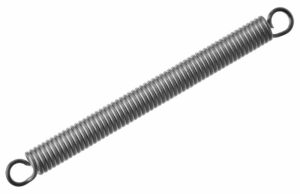
When shopping for extension springs, you may come across the term “initial tension.” It plays a key role in the performance of extension springs.
Extension springs are characterized by their ability to become longer under a tension load. They consist of tightly wound metal coil that resists pulling forces from one or both sides. While compression springs become shorter under a tension load, extension springs become longer. Some extension springs have an initial tension of 0.02 pounds, whereas others have an initial tension of up to 0.08 pounds.
The Basics of Initial Tension
The initial tension of an extension spring is the amount of force that’s built into the spring at rest. As previously mentioned, extension springs are designed to resist pulling forces. When exposed to a tension load, extension springs will become stretch, thus becoming longer. However, they will only become longer if the tension load is greater than their initial tension.
An initial tension of 0.2 pounds means the extension spring has 0.2 pounds of pulling force built into it. This initial tension keeps the coil tight. If the extension spring is exposed to a tension force of 0.1 pounds, it won’t become longer or otherwise change its shape. The tension load must be greater than 0.2 pounds to overcome the initial tension.
Why Initial Tension Is Important
You can’t ignore the initial tension when choosing an extension spring. It will affect the spring’s performance in several ways.
Initial tension promotes stability. With this built-in tension, extension springs are stable at rest. They won’t become loose or unwound, resulting in greater stability.
The load capacity of an extension spring is oftentimes influenced by its initial tension. Extension springs with a high initial tension can typically handle greater loads than those with a low initial tension. For heavy-duty applications, you should consider choosing an extension spring with a high initial tension for this reason.
Applications that require a sensitive, responsive movement may require an extension spring with a low initial tension. A low initial tension will allow the extension spring to stretch under lighter tension loads.
In Conclusion
You can think of initial tension like a rubber band that’s slightly taunt at rest. Even if you aren’t pulling on the rubber band, it will have some built-in tension. Extension springs have this same innate, built-in tension. Known as initial tension, it keeps extension springs tightly wound.
